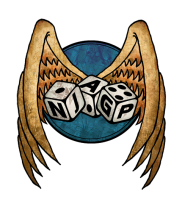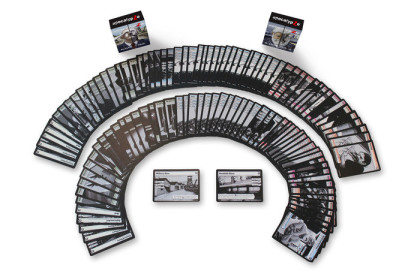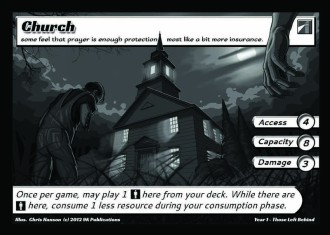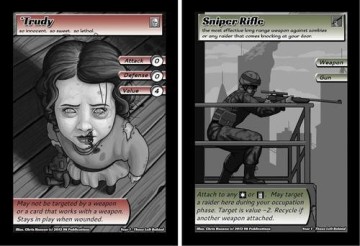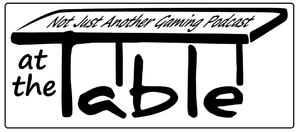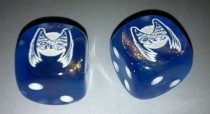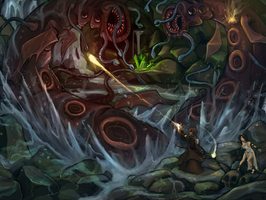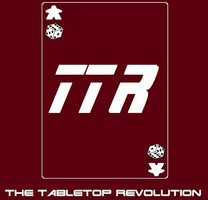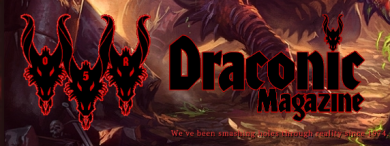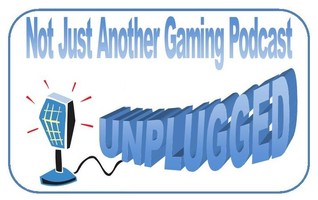ApocalypZe Card Game
NOT Just Another Zombie Game
By: JIM REED
Stop! Don't say it, don't even think it.
Throw your preconceived notions out the window.
ApocalypZe is NOT just another zombie
game. ApocalypZe is a survival, combat, resource management card
game, that just happens to be set in a post-apocalyptic world
infested by zombies. Oh, and it can be played perfectly right out of
the box, or you can dive in and fully customize your experience.
(As I wrote this review, I tried to
cover many of the rules but found it was going to be waaaaaay to
long, so for simplicity sake, I'm going to try and not bog down the
review with to much “How-To” talk. The full rulebook is available
online here … )
Surviving The Game:
Winning the game means surviving longer
than your opponents. Conserving your resources, scavenging for
resources, and protecting your stronghold are key for survival.
Raiding your opponents and send wave of attacking zombies upon them
is how you will force them to burn through their resources faster. So
what is the resources? Why the cards themselves. Each player will
have a 60 card deck that not only contains their survivors/zombies,
raiders, and actions, but each card is also a consumable resource.
When a player is forced to consume a resource, and can not do so
(because of their deck being depleted), you are out of the game.
Verdict:
This is one of the core mechanics to
ApocalypZe and one of the more innovative mechanics driving the game.
You are constantly being given the excruciating decision as to how,
where, and when to use up resources. This means that every card you
play or every card you discard (be it to consume resources to feed
your survivors or because your stronghold was just attacked) can be a
crucial to your victory. It's a very well integrated mechanic and
thematically it fits on all sides of the box.
Your Deck and You:
As of this review, the game is on kick
starter with four playable decks becoming available upon the games
release. As I said, the decks will have a ton of customization, but I
have not tinkered with this aspect of the game yet. Once more cards
are readily available, this will become easier to try. The first four
decks are:
1 – Stronghold: Roadside Diner /
Survivors: Bikers / Raiders: Gang
2 – Stronghold: Church / Survivors:
Civilians / Raiders: Cult
3 – Stronghold: Military Base /
Survivors: Soldiers / Raiders: Special Zombies
4 – Stronghold: Police Station /
Survivors: Cops / Raiders: Special Zombies
One of the simplest forms of
customization is swapping around these pairings. As an example, you
could have a deck that would put the bikers at the police station and
use the cult as your raiders.
Along with your stronghold, survivors,
and raiders (both of which will have generic characters as well as
special characters), the decks will have attachments, scavenging
locations, action cards(wild cards), and interrupts (trumps). Also,
all the general character cards are split cards. (see photo below)
This means that these cards may be played out of your hand as their
character side, or zombie side.
Verdict:
For one, the art is awesome!!! It is a
heavily detailed gray scale which makes the theme of the game ooze
off the cards. The customization seems like it's going to bring a lot
to this game. But, even if you're like me, and don't want to touch
this aspect of the game, you don't have to., The decks are well
balanced and themed out. Think of the customization as the cherry on
top. It's not needed, but if you want it, it's there. Except this is
like a dump truck load of cherries! You can choose to do very little
customizing or go all out and hand pick each and every card. As the
game ages, more and more sets will become available, giving you
endless play no mater which path you choose. The split cards are also
genius. Your deck/hand isn't clogged up with either characters or
zombies because each card acts as which ever one you decide to play
it as.
One more thing, because of the
resource/consumption/scavenge mechanic, you will almost always see
every card in your deck, so you can't say, “All my good cards were
on the bottom!”.
Playing for your life:
The game turn is broken up into phases.
First you draw cards, then you play some (occupation phase). During
this phase, one of your toughest decisions is made. You must decide
which location, and only one, you're going to play cards to on your
turn. You can place survivors at your stronghold to protect it. (this
must be done on turn 1), Your stronghold will tell you how many
characters can be there, as well as how many access points (entries)
it has. You can plop a ton of them here to defend it but, and here's
where that resource management comes into play, for every survivor
you must consume 1 resource at the end of your turn. You do this by
discard two cards from your hand for 1 resource, a card from the top
of your draw deck (This is oh so risky but necessary), or by
discarding survivors themselves (Yes, sometimes they must resort in
eating each other.) You may also have scavenging location out. These
locations allow you to send out survivors and they work by letting
you access cards from your discard pile. You may find attachments
and/or survivors while scouting and they are added to your party.
Once you complete a scavenging location, you will also be putting
cards from your discard pile back under your deck! What about those
raiders and zombies? You can choose an opponents location and play
these cards there and cause all sorts of trouble. These cards attack
your opponents. If at the stronghold, they succeed and find there way
in, your opponent must consume cards. They also can block the access
points and stop your opponents from leaving to go scavenge. If you
play at your opponents scavenging locations, they can not scavenge
and must first deal with the threat.
Verdict:
A lot of your decision making is done
here. I personally feel it is the meat and potatoes of the game. It
is very well executed and no mater what your choices, they all seem
like good ones. Now, this decision is going to be swayed a bit by the
hand of cards you hold. If you've been dropping down a ton of
survivors, you may having a hand of zombies and/or raiders. In that
case, send 'em out! The two-faced cards really help here as they can
be used in which ever tactic you're thinking of making. First time
players will also see some AP here, at least until they get a feel
for the game and it's subtleties. Thematically, this aspect of the
game is just as crucial as it should be, after all, these are the
tough decisions you would make if the zombie apocalypse became real!
Taking Actions and beefing up:
Action cards, called wild cards, can
also be played on your turn. These cards allow you immediate benefits
such as drawing extra cards or playing cards from your discard pile.
Trumps, are cards you can play even on your opponents turn that allow
you to do things such as stopping a character from being discarded,
or causing a weapon to jam. And speaking of weapons, there are a
bunch of attachments you can put into play. These include things like
weapons that beef up attack, vehicles that add benefits, defenses to
your stronghold, and items such as walkie talkies, and flashlights.
Verdict:
Theme on these cards is great. They
can help you plan strategies your opponents aren't expecting. Where
there may not be a ton of attachments per deck, they can be recycled
back into your possession through scavenging. There's nothing better
than just having a soldier with a sniper rifle be killed then to find
another one while scavenging the local general store.
Plenty to fight about:
At first, combat was one area that I
couldn't quite get a grasp of, but by the end of just my first game I
think I had figured it all out. It's simple really. You add up your
attacking parties attack value (adding bonuses for wild cards and/or
attachments and compare it to the defense of the defending party. If
your attack is higher, you do damage to what the difference is.
Example if your attack totaled 11 and the opponents defense totaled
8, you do 3 damage. All characters have a value which is like their
life points. In this example, a character with value 4 would not take
enough damage to reduce its value to 0, so the character would just
be wounded, and gets removed to the bottom of its owners draw pile.
If the characters value was 2, it would be killed and moved to the
discard pile. (besides zombies, they always go to the bottom of the
draw pile.) In this example 2, damage would still be left and have to
be assigned to another of your opponents characters if there are any.
Any zombie or raider not engaged gets through to the stronghold. Each
stronghold has a damage value and for every zombie or raider that
gets through, the player must consume that many resources. (again,
this means discarding cards).
When attacking a stronghold, those
access points stand for the number of entrances into the location.
Meaning that you can split up an attacking horde or group into as
many subgroups as you want, not exceeding the access point number. So
if a group of 6 zombies are attacking a stronghold with 3 access
points, they can attack in three parties of two. This means that the
survivors inside have to split up and try to defend these three
different access points. Each group vs. group is considered a
separate engagement and combat is done separately for each. Combat is
simultaneous, so don't forget that the attacker will be taking damage
as well.
Verdict:
While combat is as simple as it
sounds, it really is a strategic concept and one that can take some
time to fully master. Trying to decide how many groups to split your
raiders up into or how many you want to split your survivors into was
always a tough call for me. Usually ahead of time, you'll be doing
some math in your head to figure out your best plan of attack or
defense. Attachments used during combat, as well as wild cards, and
trumps can really swing an outcome. I like the fact that combat
doesn't really slow down the feel of the game. It's part of the game,
but it flows very well during turn order. You can play aggressive,
passive, or defensive, it's your choice and the standard decks allow
for this flexibility. This is one are the customization will probably
shine. Do you want to build a heavy defensive, slow consuming deck,
or an all out massive zombie horde attack frenzy deck?
Final Verdict:
It's safe to assume up to this point I
have really enjoyed my experiences with ApocalypZe. One thing I don't
have a lot of experience with is playing with more than two.
Technically, I’ve been told you could play this game with as many
people as you wanted, but the table would get very cluttered and
you'd be waiting a while between turns. I have been told it plays
great with up to four. I have had the chance to play it four players,
and I did see the potential for ganging up on players. I believe
there's going to be a way to play team versus team which I can see
could be really cool. Personally, I just love the feel of the game as
a two player game which is what I've had the most experience with.
Do NOT look at the theme of this and
think that is was a game designed around a popular theme just to
exploit the theme. ApolalypZe is a game you can tell has been
thoroughly flushed out over extensive play testing, and as I said
before, really driven around its innovative mechanics. I look forward
to seeing where the game will go in the future.
As a final note, the designers of the
game have stated that plenty of fiction was, and is, being written
along with the design of the game. So many of the characters,
factions, locations, and more, are going to have their own personal
back stories. Ivan Turner, one of the designers, has written and
published zombie fiction over the past several years and he is
bringing his talents as a writer into the world of ApocalypZe.
| Designer |
|
| Artist |
Chris Hanson
Kara Zisa
Pam Maz
|
| Publisher |
|
| Year Published |
2013
|
| # of Players |
2 − 6
|
|
|
|
| Mfg Suggested Ages |
13 and up
|
| Playing Time |
40 minutes
|
|
|

